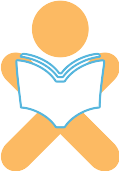Literacy
Health | Literacy | Math | Music | Biology | Chemistry -
Literacy and illiteracy are not simple opposites, but the end regions of a continuous scale. (The author writing this, a professional writer for 30 years, would like you to understand that he hasn't finished learning English.) Barely knowing an alphabet, or being able to read and write one's name, is not literacy. It is usual to define basic literacy as successful completion of a certain grade in school, but the grade varies among countries.
The following projects and discussion are about literacy projects associated with the XO, including software, hardware, and content.
ABC's
See Yay!, Bee, See for an example of a basic alphabet collection.
Getting involved
If you share our passion for literacy, please add your name below, and join us to work on improving literacy everywhere through the XO.
People
- Cliff Schmidt (at Literacy Bridge)
- Ignatz Heinz
- Ron Ahlbrecht
- --Sj talk
- ...
Projects
Avallain Basic Skills
OLPC is working with the Avallain Basic Skills project to develop an open literacy and language-learning platform that can be localized by our partner countries.
Literacy Bridge
Literacy Bridge is a project aimed at improving literacy by providing audio readers with current news and information to people to encourage awareness of new information and offer a stepping stone to literacy for both children and adults. they are working with OLPC to share channels for material and outreach; starting in Ghana. (See also Audio-based_Education.)
Notes about literacy
Functional literacy in a language using Chinese characters (mainly Chinese and Japanese, but until recently including Korean) requires knowing something more than 1800 characters (as in the Japanese Toyo Kanji set taught in elementary and secondary schools). College graduates need to know 3000 or so. Some scholars have demonstrated reading recognition of as many as 6,000. Type designers, of course know, many more by shape, but not by pronunciation and meaning. More than 90,000 characters are known historically and included in Unicode 5.0, but there is no dictionary that large.
The most effective literacy campaign in India has been karaoke-style captioning of Bollywood musicals. People will often go to see the same movie several times over, with most of the audience singing along throughout. People who thought they were too old to learn to read have been astonished to find that they were doing it.
In the International Adult Literacy Survey OECD defined Literacy “as a particular capacity and mode of behaviour: the ability to understand and employ printed information in daily activities, at home, at work and in the community - to achieve one’s goals, and to develop one’s knowledge and potential. Differences in levels of literacy matter both economically and socially: literacy affects, inter alia, labour quality and flexibility, employment, training opportunities, income from work and wider participation in civic society.”
UNESCO stresses that – especially in today’s knowledge societies – Literacy is the “key to enhancing human capabilities, with wide-ranging benefits including critical thinking, improved health and family planning, HIV/AIDS prevention, children’s education, poverty reduction and active citizenship.” A literate population is the key to development, a blossoming economy with a well educated workforce, an innovation friendly climate
According to UNESCO’s EFA Global Monitoring Report "Literacy for Life" some 771 million adults (people aged 15+) worldwide are considered to be illiterate.
In the Education for All (EFA) Goals (also known as Dakar Goals), the world community committed itself to the goal of reducing the illiteracy rate by 50% by 2015. In the Millennium Development Goals the world community committed itself to achieve universal primary education. To support the importance of Literacy as part of these goals, the United Nations General Assembly has declared the period from 2003 to 2012 as the United Nations Literacy Decade (UNLD).
Think before you print: literacy in the digital appliance age
See Printing_Culture.
External Links
There are a number of published sources for national literacy rates and related data. The numbers are only approximate, because they depend on the definition of literacy used, and the counting or sampling methodology.
- The UNESCO Global Monitoring Report "Literacy for Life" gives a good insight on Literacy worldwide
- UNICEF is a good starting place.
- Final Report of the International Adult Literacy Survey (The IALS of 2000 developed modern literacy metrics and examined them for 20 (developed) OECD nations.)
